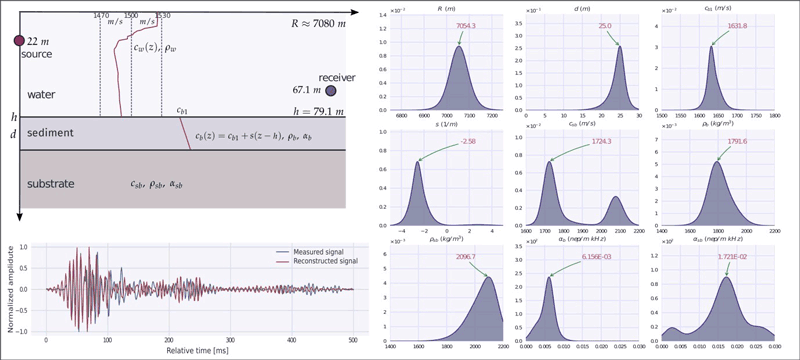by Costas Smaragdakis and Michael I. Taroudakis (University of Crete and IACM-FORTH)
The analysis of long time series of measured acoustic or seismic signals may lead to the extraction/determination of specific features that characterise the signals and the information they carry. Two scientific fields that could make extensive use of signal characterisation are acoustical oceanography, where the acoustic signal can be used as a monitoring tool of the marine environment and seismology in which the seismic signals are rich in information about the geological structure of the earth. We are developing alternative tools for signal characterisation based on a time-frequency analysis of the corresponding recordings followed by a probabilistic feature extraction driven by the hidden Markov theory, a well-known machine learning approach for describing sequential data.
The probabilistic characterisation of signals has been applied, to date, with simulated and real data for problems of acoustical oceanography related to ocean acoustic tomography or geoacoustic inversions [1],[2].
In typical applications of acoustical oceanography a signal of known type is emitted from a sound source and is recorded at some distance from it. The determination of the signal features are used as the first step of an inversion procedure leading to the estimation of the environmental parameters of interest; typically the sound speed structure in the water column and the sea-bed properties, using an appropriate underwater sound propagation model. These parameters are the necessary input data for a variety of models that address the dynamics of the marine environment. The topic of this article is feature extraction/signal characterisation using machine learning techniques.
The signal feature extraction procedure presented here, “probabilistic signal characterisation scheme” (PSCS), consists of two stages. In the first stage, the signal is decomposed into several time-frequency layers using the stationary wavelet packet transform. This analysis provides a well translated-invariant time-frequency representation of the signals, revealing hidden trends and patterns of the data.
In the sequel, the energy significant wavelet coefficients are modelled by a left-to-right Hidden Markov Model (HMM) with Gaussian emission distributions. Such models introduce a hidden variable for each time step and this variable is considered responsible for generating the observed data (wavelet coefficients in our case). Each hidden variable can take one of a predefined number of different values (states). The optimal number of hidden states is calculated using the “Bayesian Information Criterion” (BIC). Thus, an acoustic signal is characterised by means of the parameters determining the HMM. These parameters are the transition matrix and the parameters of the emission distributions. Signal similarity measures are obtained using the Kullback-Leibler divergence (KLD) between the representative HMMs for replica and actual earthquake measurements.
The same procedure is used with seismic signals. Most earthquakes are triggered by a slip over a fault area in the Earth’s crust. Probabilistic feature extraction of the seismographs included in some data base of a certain region (representative history of earthquake activity in the region) may lead to the association of the triggered faults with single plane simulated faults. Just like the problems of acoustical oceanography, an appropriate earthquake propagation model should be applied to obtain simulated signals which will also be characterised using the HMM. A similarity measure capable of quantifying the differences between the probabilistic features of each replica signal with the corresponding features of the measured signal of the actual ground motion is once more obtained by the Kullback-Leibler divergence (KLD).
The set of the optimal simulated source mechanism of actual earthquakes can be then used to acquire knowledge about the earthquake cycle (motifs) in a specific region, or cluster of regions.
As an example of the use of the probabilistic signal characterisation scheme in acoustical oceanography, we present a geoacoustic inversion problem of recovering the sea-bed properties of a marine environment using a single recording of the acoustic field due to a known underwater sound source. Figure 1 shows a model of the marine environment corresponding to the experimental track of the SW06 experiment, an underwater acoustics experiment held in the Atlantic Ocean, close to the New Jersey shore. The experiment involved light bulbs as acoustic sources imploded at a depth of 22 m and recorded at a depth of approximately 78 m and range of 7 km. Figure 1 presents the inversion results obtained after applying the PSCS scheme to the recorded and replica signals and using a genetic algorithm over a wide search space on the sea-bed parameters shown in the figure as symbols (not values). These are: The sound speed and density of the sediment layers, the thickness of the sediment layer and the sound attenuation coefficients, with the range R being an additional unknown. The results are expressed by the posterior distributions of the unknown model parameters over the final population of the genetic algorithm. Finally, Figure 1 provides the comparison of the measured and the reconstructed signals by exploiting the values which maximize the marginal posterior distributions.

Figure 1: The modelled marine environment of the SW06 experiment, the inversion results in terms of the posterior distributions of the model parameters, and the measured and reconstructed signals.
Our next research goals include the introduction of a complete toolbox based on a state-of-the-art model-based reinforcement learning (RL) technique for providing solutions to a wide class of problems related to the acoustic monitoring of the marine environment, and the risk assessment of the seismicity in selected areas of Hellenic with high earthquake activity.
References:
[1] C. Smaragdakis: “Acoustic Signal Characterization using Hidden Markov Models with applications in Acoustical Oceanography”, PhD Thesis, Heraklion, 2019.
[2] C. Smaragdakis and M. Taroudakis: “Hidden Markov Models feature extraction for inverting underwater acoustic signals using wavelet packet coefficients” in Proceedings Euroregio 2016, Porto, 2016.
Please contact:
Costas Smaragdakis, IACM/FORTH and University of Crete, Greece
Michael I. Taroudakis, IACM/FORTH and University of Crete, Greece











